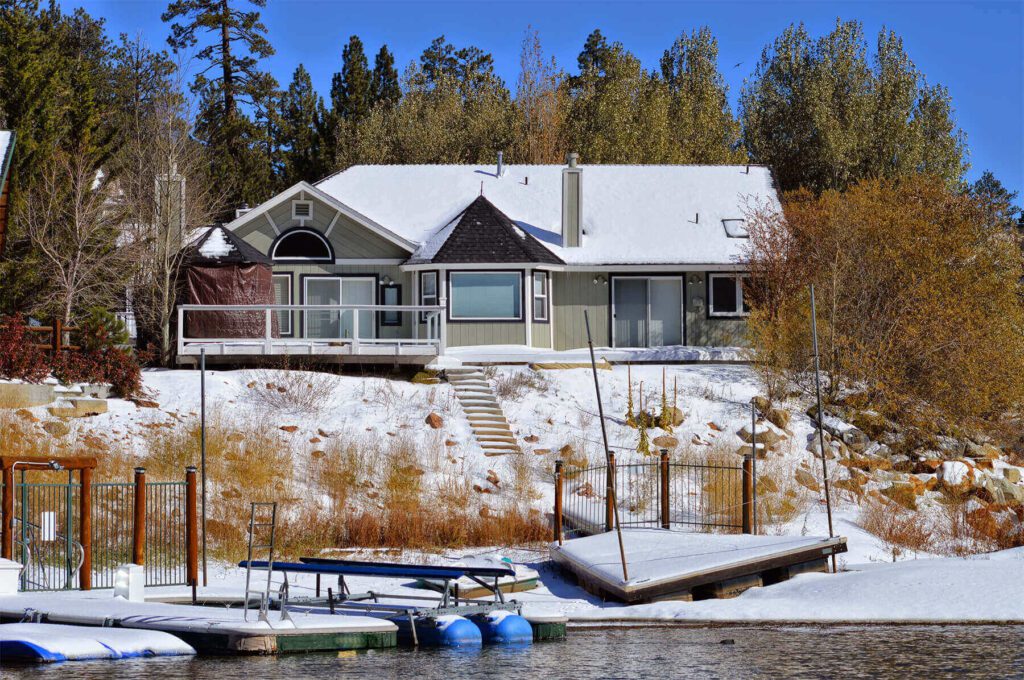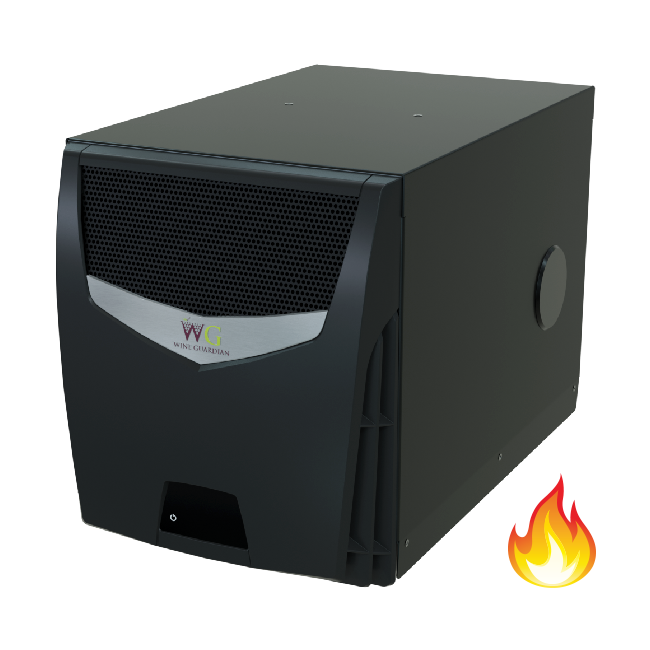
Cold weather is an important factor influencing the functionality of climate control technology for wine storage and aging. A wine cellar or room must be able to maintain a consistent temperature of 55°F to 57°F (12°C to 14°C) and a relative humidity level of 50% to 70% — even in the dead of winter. If temperatures dip too low, a wine cooling unit without a heating element won’t be able to bring the temperature back up to the control set point. In such cases, especially in frigid climates or second homes that go unheated for long periods of time, heating your cellar will be necessary.
At Wine Guardian, we offer a selection of climate-controlled wine storage solutions. Learn more about how excessively cold temperatures can negatively impact your wine as well as your options for heating a wine cellar to maintain ideal storage temperatures.
Dangers of Cold Temperatures for Wine
It’s not just keeping your wine cellar above freezing that’s of concern; the temperature conditions in your storage space must remain stable, consistent, and above the set point to prevent damaging your collection over time. Wine won’t age properly if your cellar’s temperature stays below 55°F for an extended period. In very cold long-term storage environments, white wines tend to be particularly fragile.
Fluctuating temperatures can be even more harmful to wine quality. Such changing conditions accelerate the wine aging process and deprive your wine of some of its flavor. The wine and its bottles will expand and contract as the temperature in your cellar rises and falls. Cold air will damage the corks, then make its way through them to enter bottles and replace the wine’s aroma. Changing temperatures can cause bottle breakage, as well.
Assessing Your Cellar’s Cold Climate Challenges
In concert with selecting the best wine cooling unit for your cellar or room, it’s important to begin with a well-constructed space. Similar to keeping cold out of a residential space, insulation and a vapor barrier are great places to start. The quality of the glass and doors is also important to creating a consistent environment for your wine collection. Ideally, the glass will be double-paned and insulated. Wine room doors should be of commercial and exterior-grade quality with a tightly sealed threshold, all in the interest of keeping the elements away from your wine.
Continuing to evaluate your storage environment over time is also beneficial for protecting your investment. In the winter months, many regions experience extended periods with temperatures below 40°F, impacting not only your wine collection but also your cellar’s compressor. Regularly monitoring your storage space using a thermometer will help ensure optimal, consistent temperatures. Keep in mind that, when they do occur, drafts or cold spots in your cellar are typically located around any exterior walls or close to the floor.
Humidity is another environmental factor to consider. Cold air tends to be less humid, and the lack of moisture can result in dry cellar conditions. This may dry out bottle corks and negatively impact your wine. You can use tools like a hygrometer for monitoring and verifying humidity levels to assess conditions in your storage space.
Wine Guardian Heating Solutions for Wine Cellars
Wine Guardian offers two factory-installed options specifically designed for cold-climate applications: low ambient protection and electric heat.
Low Ambient Protection
Low ambient control options are beneficial when the condenser is exposed to temperatures of 40°F (4°C) or lower, conditions that impede the compressor’s performance. Wine Guardian’s low ambient protection has two main components to combat these challenges. First is a crankcase heater underneath the compressor that keeps system oil at elevated temperatures to prevent freezing.
The second is a fan cycling switch that turns the condenser fan on and off to hold refrigerant pressures at preset levels and give you airflow control over the condenser. This option is installed at the Wine Guardian factory and should be indicated when you order your wine cooling unit. Low ambient controls can be added to ducted or ducted split systems of any size to meet the needs of large or small wine storage rooms in cold environments.
Electric Heat
Alternatively, choosing an all-in-one system that integrates an electric heating element into your cooling unit delivers the following benefits:
- Precise temperature stability with automatic heating activation. Wine Guardian’s electric heat option is necessary when the rooms surrounding the wine cellar drop below 50°F (10°C) for extended periods. Activating automatically, our heater warms the air as it enters the wine room, raising the temperature by 5°F to 12°F depending on the size of the cooling unit. Maintaining a constant set point protects your wine collection from being too cold, which affects the aging process.
- Unified thermostat control to eliminate temperature conflicts. The best systems integrate heating into the cooling unit so they work off the same thermostat. This prevents any overlap from a freestanding heater and the cooling unit running simultaneously. With the enhanced efficiency of a single thermostat, a Wine Guardian cooler with heating will keep your wine’s temperature constant throughout the year.
- Space-saving design for compact and easy installation. In addition to having a 500-watt heating capacity, integrated systems are compact and simple to install. You benefit from the functionality of the heating element without requiring a large unit that will take up valuable space in your wine cellar.
Wine Cooling Units With Integrated Heaters
For clients trying to determine how to heat a cellar, Wine Guardian has electric heaters that integrate with any size ducted or ducted split system operating at either 50 or 60Hz. They’ll allow you to either heat or cool the air in your cellar, ensuring your wine is always protected regardless of outside temperatures.
Our three through-the-wall cooling units with integrated wine cellar heaters are as follows:

TTW018H. The 60Hz TTW018H system has a capacity of 981 to 1845 BTUH. It’s an ideal option for heating small residential cellars.

TTW009H. Another residential 60Hz system, the TTW009H ranges in capacity from 250 to 999 BTUH for smaller wine rooms.

WG25H. With a capacity of 0.21 to 0.41kW, this 50Hz system is for our residential customers across most of Europe, Africa, Asia, Australia, and New Zealand with large wine cabinets or cellars of 20 by 35 m3.
These models include an integral electric heating element, thermostat, thermal overload protection device, and controls. For select ducted, ducted split, ductless split, and Wine Guardian Pro units, wine cooler heater and low ambient protection options are also available.
Protect Your Wine Collection: The Wine Guardian Advantage in Cold Climates
Wine Guardian’s wine cellar cooling units are commercial-grade climate control systems designed specifically for high-end residential wine cellars, institutional wine rooms, restaurants, and commercial storage facilities. They’re available in several sizes to condition fine wine collections from fewer than 500 bottles to over 20,000 bottles. These units will maintain optimal temperature and humidity so you can keep your wine in the correct aging conditions.
The units are well suited to many different types of locations up to 25 feet away from the wine cellar. Wine Guardian products are made of commercial-grade components and corrosion-resistant, powder-coated aluminum for durability. They are ETL and CSA safety certified.
Our products are distributed internationally. Wine Guardian representatives can help you determine which size unit you need and which options are best for heating a cellar of your design and storage requirements. It’s our goal to assist you in preserving the enjoyment of your valuable wine investments. Contact us today for more information on how Wine Guardian systems and accessories can support proper temperature conditions in your cold-climate cellar.

